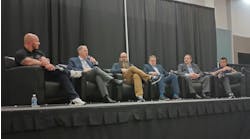As I work with customers pursuing OEM certifications, I often leave them with homework after my first visit. The first thing I ask them to do is review the Collision Industry Conference (CIC) Collision Repair Provider Definition and complete a self-evaluation for their business. This helps them determine if they are ready for OEM certification. Next, I challenge them to think about which OEMs they would like to be certified for, why they would pick a particular OEM, and what value and benefits that certification would bring to their business.
Deciding which OEM certifications to pursue is a different decision for a dealer than for an independent facility. Dealerships should first obtain the certification for the brand they market, but independents require more research to identify which is best for them. For both customer types, I recommend starting with a market review to determine the opportunity for specific brands that are registered in their market area. Independent repair facilities can compare a market review to a management system report that shows the number of each brand they currently repair. If the management system report shows that the shop is repairing a high number of cars of a specific brand, it indicates that certification for that brand could bring more value to the business.
This process is also important in evaluating the market opportunity for dealerships. I recently worked with a multi-franchise dealer, and through a market review we found that they would be certified for 29.5% of the registered vehicles in their area if they were certified for their franchised brands. We also learned that one of the franchise brands was in a program that would allow them to become certified in three other brands, adding 24.9% in registration coverage. With a total of seven certifications, they would have over 50% coverage of the top ten vehicles registered in their market. A careful review proved they didn’t need many certifications, just the ones that made sense.
Determine equipment needs for various OEM programs and prepare your facility
As we continued the process, we reviewed the OEM requirement checklists to compare the expectations of each manufacturer. We found many similarities, so we picked the most stringent and inspected the shop. We kept the other checklists handy so we could validate the exceptions. This is vital when reviewing equipment requirements because one OEM might want a specific piece of equipment while another doesn’t specify a particular brand or type. I recommend working with an equipment distributor to review the requirements, as one piece of equipment might meet the requirements for several OEMs.
Once you decide on an OEM and submit the application for certification, things begin to happen quickly. The first step is typically an on-site audit where you will be checked for everything you submitted on the application. You can’t prepare for this visit like you do when you call your spouse at 4:30 p.m., saying, “I’m bringing a friend over for dinner” and making a mad dash through the house picking things up. They are going to look closely at your facility. So, if you have disorganized shelves or scattered equipment throughout your shop, straighten it up beforehand. I recommend facilities review the 5S process to help prepare for an on-site audit.
Preparing for and gaining an OEM certification is the first step in improving your business. As part of the homework I give customers, I ask what value and benefits they expect an OEM certification to bring to their business. It is important to understand that gaining an OEM certification will not immediately improve your business. How you market the value and benefits to your customers is what brings the advantages of OEM certifications. You know the value, how you relate that to your customers so you are the repair facility of choice is what will bring the benefit to you. Look for more on this in future articles, for now take a good look at your facility to see which OEM certification is the best fit for you as you pursue sustainable business growth.




